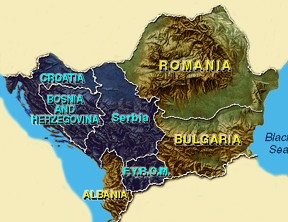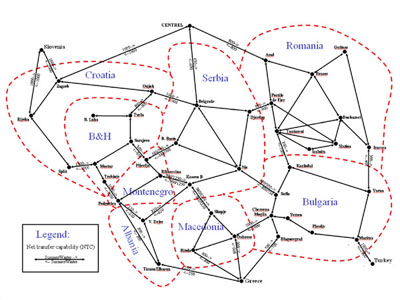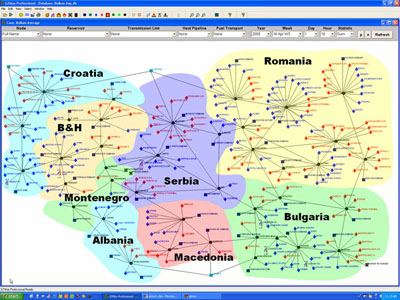| Center for Energy, Environmental, and Economic Systems Analysis (CEEESA) |  |
Research Areas:
Energy, Environment, and
Economics
National and Homeland
Security
Infrastructure Assurance
Emergency Preparedness
Social Dynamics
Policy Analysis
Core Capabilities:
Systems Analysis
Modeling, Simulation, and
Visualization
Complex Adaptive Systems
Decision Support and Risk
Management
Information Sciences
Southeast-European Regional Electricity Market Analysis
The study modeled the operation of electric power systems in eight countries in Southeastern Europe. Included were the electric utility systems of Albania, Bosnia and Herzegovina, Bulgaria, Croatia, Macedonia, Romania, Serbia, and Montenegro. Turkey also participated in the project as an observer country but was not modeled. As part of the project, the GTMax software was distributed to all participating countries. USAID also sponsored a brief introductory training course for regional utility experts on the use of GTMax. Methodology: The GTMax analysis takes into account the topology of the electric power systems, interconnection transfer capabilities, chronological hourly loads, and the differences in the electricity generation costs in each of the utility systems. GTMax calculates market prices for electricity sales/purchases in different regions (market hubs) of the power network based on the capacity constraints of transmission interties. The model simultaneously optimizes power transactions to minimize overall operating costs in the region. The above network topology was implemented in GTMax by developing a detailed modeling representation of the regional market as a network of nodes (electricity market hubs) and links in GTMax. The first screen shot below shows the entire network that contains all eight power pools (click on the picture to see a larger version). The second screen shot shows one of the power pools in the system (click on the picture to see a larger version).
LMP Calculations: GTMax computes market prices of electricity at various geographic locations within the power systems and at power system interconnections. The market price is assumed to be the marginal cost of delivering energy to a specific location, or locational marginal price (LMP). The companies that generate power are paid LMP at the point of power injection; that is, the price is dependent on the supply and demand equilibrium. In principle, the LMP price can be equal to, less than, or greater than a generator’s average production cost. In this study it is assumed that generators bid energy blocks into the market at marginal production costs. Since the market structure for the Southeast Europe has not been determined, the results provided in this report were calculated with the assumption that the LMPs will be based on the marginal production costs of generating units. Note that in the actual operation of the regional electricity market in 2005, depending on the market structure that will be adopted, generation companies may opt to use different bidding strategies, some of which may not be directly related to marginal production costs. Therefore, their income and revenues may be different from those in this report, depending on the adopted market structure and market rules and how the market clearing prices are determined. Another factor in determining LMPs is the transmission network and its transfer capabilities. In principle, if there is no transmission congestion, power can be transferred to any node of the network and all nodes have approximately the same LMPs (small differences may occur because of transmission losses/costs). However, in the case of transmission congestion, the transport of power to a certain region in the network may be limited by the transfer capabilities of the transmission lines connected to that particular area, thus creating a zone with higher LMPs. Differences in LMPs between two connected regions are used to compute congestion line charges. This study takes into account possible transmission congestion on the interconnection links between the power systems. Internal transmission congestion within individual utility systems was not considered. Hourly Simulations: The hour-by-hour simulation of an entire week (168 consecutive hours) was considered very important in order to capture the operational behavior of hydro and pumped-storage power plants in the region. Most hydro power plants in the region have at least daily regulation capabilities and operate differently during the peak and off-peak hours (e.g., during the day and during the night). Also, in the case of hydro plants with greater storage capabilities there are significant differences between their operation during the weekdays and during the weekends. In order to capture the uncertainty of water inflows and effects of different hydrological situations on the operation of hydro power plants, the analysis was carried out for three hydrological conditions: wet, average, and dry. Under both the independent operation and regional market scenarios, the utility systems of the participating countries were represented with the generation and transmission facilities that correspond to the expected system configurations in 2005. Similarly, under the regional market scenario, the utility systems were interconnected into a regional network with the existing interconnection lines and with those that are expected to be in operation in 2005 (see the figures above). The power transfer capabilities of the interconnection lines were also taken into account during the GTMax simulations of the hourly operations of a regional electricity market. In principle, for the simulation of a regional electricity market, GTMax was used to calculate hourly values of LMPs for all nodes (market hubs) of the regional network and to optimize power transactions among the utility systems. Power transactions were subject to the capacity limits (net transfer capabilities) of the interconnection links among the systems. The resulting LMPs, taking into account the power transactions, were also calculated and reported by the model for each node of the regional network. Ancillary Services: Since hydro and pumped-storage power plants provide most of the ancillary services for practically all of the utility systems in the region, GTMax was also used to calculate and compare the production of ancillary services under two scenarios for all of the utility systems. Model Transfer, Training, and Capacity Building: At a project workshop in Montenegro (October 14-18, 2002), CEEESA staff presented initial model results, transferred copies of the software to 14 participating institutions, and provided basic training in GTMax to more than 30 regional participants.
Results of Analysis: The final report was submitted to USAID in January 2003. The results and the report can be made available on request. A paper that was presented at an IEEE conference in Toronto is available below that summarizes some of the study results. Additional Resources: For more information on this application and the GTMax model, download the following brochures, presentations, and papers in pdf format:
For more information, contact contact CEEESA |
| U.S. Department of Energy Office of Science | UChicago Argonne LLC |
| Privacy & Security Notice | Contact Us | Search |
 Background: Sponsored by the US Agency for International Development (USAID) and collaborating with Montgomery Watson Harza (MWH) and CMS Energy, experts from the Center for Energy, Environmental, and Economic Systems Analysis (CEEESA) used the Argonne-developed Generation and Transmission Maximization (
Background: Sponsored by the US Agency for International Development (USAID) and collaborating with Montgomery Watson Harza (MWH) and CMS Energy, experts from the Center for Energy, Environmental, and Economic Systems Analysis (CEEESA) used the Argonne-developed Generation and Transmission Maximization (


